|
|
|
|
Body image linked to extant batoids, tooth image to fossil teeth |
| PRISTIFORMES |
| PRISTIDAE Bonaparte, 1838 - Sawfishes |
 |
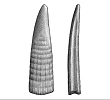 |
Pristis. Purdy et al (2001) reported one Yorktown (unit ?1) specimen with a posterior groove as Pristis cf pectinatus LATHAM, 1794, three others (lacking the groove) were deemed Pristis juveniles. Accompanying image is an Eocene example. |
| |
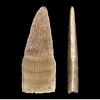 |
Anoxypristis. Purdy et al (2001) deemed this rostral spine-design as juvenile Pristis -- they compare better with the Anoxypristis tooth-design. |
| |
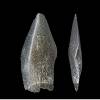 |
Propristis. A single Pungo River specimen is known that would appear to represent a Propristis rostral spine. |
| RHINIFORMES |
| RHINIDAE Müller & Henle, 1841 - Wedgefishes |
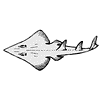 |
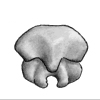 |
Rhynchobatus teeth are regularly found when sifting Pungo River and lower Yorktown sediments. This genus no longer inhabits western Atlantic waters. Purdy et al (2001) make no mention of this taxon. |
| RHINOBATIFORMES |
| RHINOBATIDAE Müller & Henle, 1837 - Guitarfishes |
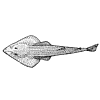 |
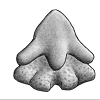 |
Rhinobatos. Purdy et al (2001) report this genus as present in Pungo River units 4 & 5; extensive collecting by this author has failed to find an example which might not be better referred to Rhynchobatus. Accompanying image is an Eocene example. |
| RAJIFORMES |
| RAJIDAE Blainville, 1816 - Skates |
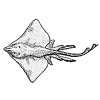 |
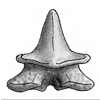 |
"Raja". These teeth are common in Pungo River sediments and abundant in basal Yorktown; Multiple genera/species are represented by teeth and thorns, Purdy et al (2001) report two teeth (Yorktown unit 1) attributed to R. laevis MITCHILL, 1817. |
| MYLIOBATFORMES |
| DASYATIDAE Jordan, 1888 - Whiptail Stingrays |
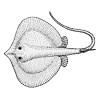 |
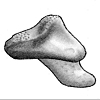 |
Dasyatis. Stingray teeth are abundant in the Pungo River, less so in the Yorktown. Several variations of Dasyatis are found and three + species are likely represented.
Purdy et al (2001) included three species: |
| |
D. say (LESUEUR, 1817) — 433 teeth (no denticles)
ascribed to this genus from the Pungo (units 1-5) and Yorktown (1 & 2).
D. centroura (MITCHILL, 1814) — 350 denticles (no teeth) from Yorktown units 1 & 2.
D. americana HILDEBRAND & SCHROEDER, 1928 — a single (?pathologic) tooth from the Pungo River units 1-3.
Although these three species are likely to be present in the fauna, I'm uncertain that individual specimens have been identified properly. |
| RHINOPTERIDAE Jordan & Evermann, 1896 - Cow-nose Rays |
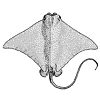 |
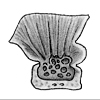 |
Rhinoptera are the most common ray teeth found when surface collecting the Pungo River. Two Rhinoptera tooth-designs are commonly found. Purdy et al (2001) included this genus from the Pungo River (units 1-5) fauna. |
| MYLIOBATIDAE Bonaparte, 1838 - Eagle Rays |
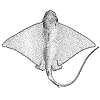 |
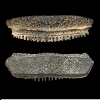 |
Myliobatis - Eagle rays are attributed to most Cenozoic locales, but at Lee Creek, few can be confidently identified because they are usually severely worn before being shed. |
 |
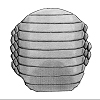 |
Pteromylaeus - Bull ray.
Known from its elongated medial teeth and a number of toothplates, Purdy et al (2001) include this genus in the Pungo (units 1-5) fauna. This taxon is no longer present in the western Atlantic. |
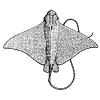 |
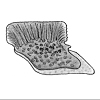 |
Aetobatus - Bonnet ray teeth can be readily identified by their lateral margin. The only real question is to which Aetobatus species they should be attributed to. Purdy et al (2001) settle for Aetobatus sp from the Pungo (units 4 & 5) and Yorktown (units 1 & 2). |
| MOBULIDAE Gill, 1893 - Devil Rays |
|
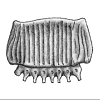 |
Plinthicus - extinct devil ray.
The teeth of P. stenodon are a common Pungo River tooth. Purdy et al (2001)
include these teeth in the Pungo River fauna (units 1-6) and included them as a rhinopterid. |
|
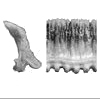 |
Paramobula. - extinct devil ray. The teeth of Paramobula fragilis are relatively uncommon in Pungo River sediments and usually damaged. Purdy et al (2001) include three mobulid tooth-designs, one of which (14j-l) compare well with P. fragilis (CAPPETTA 1970). |
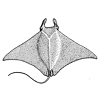 |
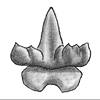 |
Mobula - Devil ray. teeth are common when sifting the Pungo; particularly M. loupianensis CAPPETTA, 1970. Purdy et al (2001) include as Mobula spp, the teeth of M. loupianensis (Figs 14a-f, m-o) and M. cf pectinata CAPPETTA, 1970 (Figs 14g-i) |
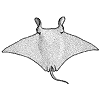 |
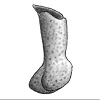 |
Manta - Manta ray. The accompanying basal Yorktown tooth of Manta hynei represents the first example of a Manta tooth from the fossil record. Purdy et al (2001) include this genus as evidenced by some thirty osseous masses with caudal spines recovered from Yorktown units 1 & 2. |